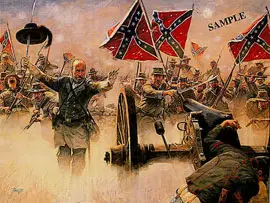Civil War Battles |
Colonial Wars |
American Wars |
Link To This Page — Contact Us —
The Battle of Mansfield/Sabine Cross Roads
April 8, 1864 in Mansfield, Louisiana
Red River Campaign
Union Forces Commanded by:
Maj. Gen. Nathaniel P. Banks
Confederate Forces Commanded by: Maj. Gen. Richard Taylor
**Missing and Captured Conclusion: Confederate Victory |
 |
BATTLE SUMMARY
The Battle of Mansfield, also known as the Battle of Sabine Cross-Roads or Pleasant Grove, was the first major clash of the Red River Campaign.Maj. Gen. Nathaniel P. Banks's contingent of over 12,000 men had advanced about 150 miles up Red River. They were within 25 miles of the Texas border, but lost contact with the accompanying gunboat fleet, due to low water conditions and the necessity for the army to follow an established road that turned inland away from the river.
Maj. Gen. Richard Taylor, in command of the Confederate forces, along with his subordinates Brig. Gen. Thomas Green and Maj. Gen. Camille de Polignac, decided that it was time to try and stop the Union drive. They were determined to make a stand near Mansfield against the direct orders of his more cautious superior, Maj. Gen. E. Kirby Smith, the commander of all Confederate forces west of the Mississippi River. A few miles more of Union advance and Bank's troops would be at Sabine Cross-Roads, from which they could advance in most directions. Taylor had to stop them before they got to the crossroads, because he wasn’t strong enough to chase them if they spread out.
In mid-March, Banks' 25,000-man army began moving uo the west bank of the Red River in central Louisiana. Accompanying it on the river was a large flotilla of gunboats and transports commanded by Rear Adm. David D. Porter. Late in March, another Union army, 13,000 strong under Maj. Gen. Frederick Steele, headed south from Little Rock, Arkansas. The objective of both expeditions was Shreveport, the military, political, and economic center of the Confederate Trans-Mississippi Department.
To meet this 2-pronged invasion, Smith had barely 25,000 men divided between Taylor in western Louisians and Maj. Gen. Sterling Price in Arkansas. Correctly perceiving the Banks-Porter expedition as the more dangerous, he sent Brig. Gen. Thomas J. Churchillwith 5,000 of Price's infantry to reinforce Taylor, who meanwhile fell back to Sabine Cross Roads south of Mansfield.
On April 8, during the morning, the Federals probed the Confederate lines. There was little weight behind the probes because Banks had left the cavalry almost unsupported, and the infantry had trouble getting around the cavalry’s wagons on the narrow road. Taylor decided to give battle to Banks even though he had only 9,000 men and Churchill had not yet arrived.
Late that afternoon, one of his divisions attacked the head of the Union column, which had been reduced to 20,000 men by detachments. Charging forward like "infuriated demons", the Confederates smashed one , then another of Banks' division, causing them to flee in panic-stricken route. Taylor pursued vigorously, capturing 20 cannon, scores of wagons, and hundreds of prisoners.
Confederate forces attacked the disorganized Federals and decisively routed them. Both pursuit and reinforcement were hampered by the Union wagon train's blockage of the narrow road, which fell into Confederate hands. Banks displayed great personal bravery in attempting to rally his troops.
Finally, at 6:00 P.M. with darkness descending, a third Union division checked the Confederate pursuit about 3 miles from the original contact and halted it after more than an hour's fighting. The Union army had suffered heavy casualties, the loss of supplies, and was demoralized. The Confederates had many casualties and were consumed with hope that the entire Union expedition could be destroyed.
The Federals resumed their retreat, which continued through the night to Pleasant Hill. There, they would again have to fight on April 9.
